
[ad_1]

Don’t get me wrong. All of these things are important.
But pump the brakes.
Before you can maximize your open rate and engagement, you must first make sure that your emails are actually being delivered and finding their way to the inbox.
Otherwise, what’s the point?
And this is a bigger issue than you may think.
According to Return Path’s 2017 Email Deliverability Benchmark Report, 20 percent of email never reaches the inbox.
Instead, it winds up getting lost or in the spam folder.
So theoretically, one out of every five of the emails you send never makes it to the inbox.
And this can really marginalize the impact of your campaign in the long run.
Just think about all of the lost leads and squandered opportunities.
Right now I’d like to discuss some actionable steps you can take to improve email deliverability and ensure that more of your emails reach the intended recipients.
FREE DOWNLOADABLE BONUS
Want More Email Marketing Inspiration?
Let’s face it: writing good marketing emails is TOUGH. To help, we’ve put together an email marketing swipe file, including 41 email marketing examples (organized by category). Plus, a few other goodies not featured below (*cough* killer Facebook Ad examples *cough*).
Download All Resources Now →

Follow These 8 Email Deliverability Best Practices for Higher Open Rates
This article is quite in-depth. To make life easier, I’ve broken each best practice down in more detail. Click a link below to jump to a particular section of interest.
1. Build Your IP Credibility
2. Use a Confirmed Opt-In
3. Simplify the Opt-Out Process
4. Be Consistent with Your Sender Name
5. Don’t Overdo It with Your Emails
6. Stick to a Consistent Schedule
7. Use Segmentation
8. Create a Suppression List
Let’s look at each strategy in more detail.
1. Build Your IP Credibility
Spam has been and continues to be a major annoyance for email users.
Just take a look at the global spam volume as a percentage of total email traffic was from January 2014 to September 2017 according to Statista—as high as 71% and no lower than 52%.
Spam accounts for the majority of email—59.33 percent as of the latest report in September 2017.
What’s crazy is that’s actually an improvement from what it was in 2014. People all over the world are drowning in spam.
So ISP filters are constantly waging war against it.
To do so, they assess the IP of incoming emails to see how trustworthy they are.
If your IP seems suspicious, there’s a good chance that your email won’t reach the inbox.
So what you want to do is build your IP credibility. But how?
I recommend starting slow with an email campaign and only sending a small batch of emails to individuals who you know are engaged.
Once an ISP sees that recipients are opening and engaging with those emails, your IP should become more trustworthy.
Then over time, you can gradually increase the volume of your emails.
I also suggest checking your IP reputation (if you haven’t already).
This is easy to do and only takes a few seconds.
Check out this post from SendGrid to learn about some of the best tools for doing this.
You may also want to use the MxToolbox Email Blacklist Check to see if your IP address has been blacklisted.
2. Use a Confirmed Opt-In
Also known as a double opt-in, a confirmed opt-in is where a person receives a confirmation email after subscribing.
From there, they confirm that they do in fact want to subscribe to your email list.
Here’s a good example from North Wild Kitchen.
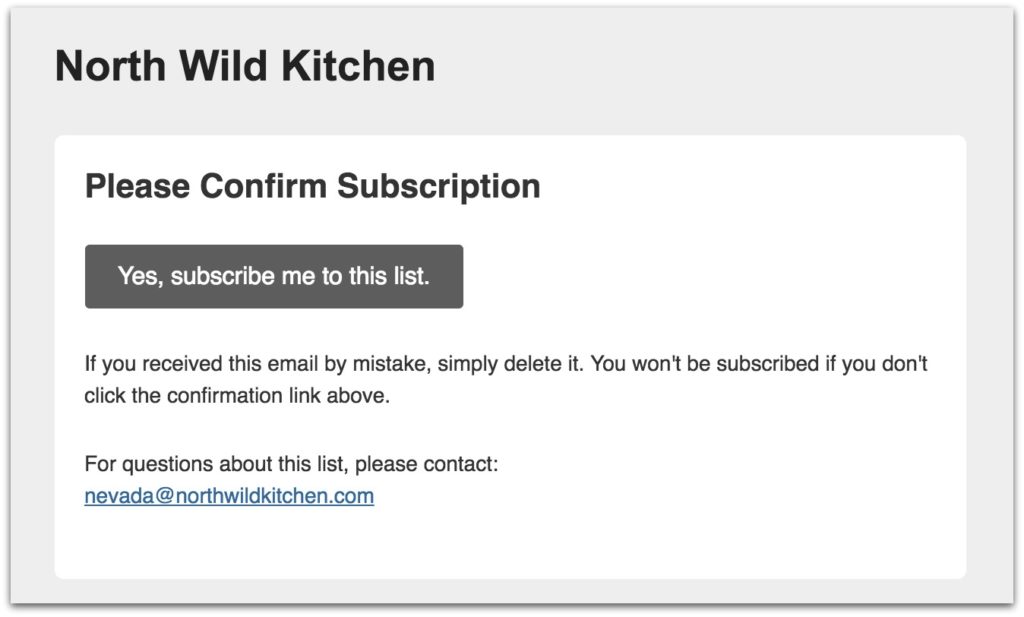
While using a single opt-in or even a pre-checked box to subscribe may be tempting because of the volume of subscribers you’re likely to generate, it can hurt your long-term deliverability rate.
Why?
Because it can generate spam complaints, which are the kryptonite to your deliverability rate.
And there are some other major advantages associated with confirmed opt-ins including lower bounce rates, higher open rates, higher-quality leads, more engagement and lower unsubscribe rates.
While it will probably take longer to grow your email list using a confirmed opt-in, it’s pretty much guaranteed to improve email deliverability.
Not to mention, it’s compliant with the CAN-SPAM Act, which will help you avoid ugly penalties from the FTC.
3. Simplify the Opt-Out Process
I’m sure that by now you know you’re required to give subscribers the chance to opt-out at any time.
This is actually mandated by the CAN-SPAM Act.
But besides the legal aspect, it’s just good business.
After all, you don’t want to create any resentment when someone wants to unsubscribe from your email list but isn’t able to.
But here’s the thing.
Not only do you want to allow subscribers to opt-out, you want to make it incredibly easy for them to do so.
Why?
If someone can’t quickly find the unsubscribe box, they may end up marking your email as spam in order to avoid receiving future emails from you.
As I mentioned earlier, getting spam complaints is toxic to your IP and your email deliverability.
So what you want to do is place an unsubscribe button in a conspicuous location so that people can find it without any fuss.
I also recommend going with one-click unsubscribe for added convenience.
Just think about it. The last thing someone who’s already frustrated wants to do is jump through a bunch of hoops to opt-out.
Finally, be sure that you provide them with some sort of confirmation that they’ve successfully unsubscribed.
Here’s a good example:

Or if you want to gather some insight as to exactly why someone chose to unsubscribe, you can always include the option for them to provide their reasoning.
I’m sure you’ve come across one of these before.
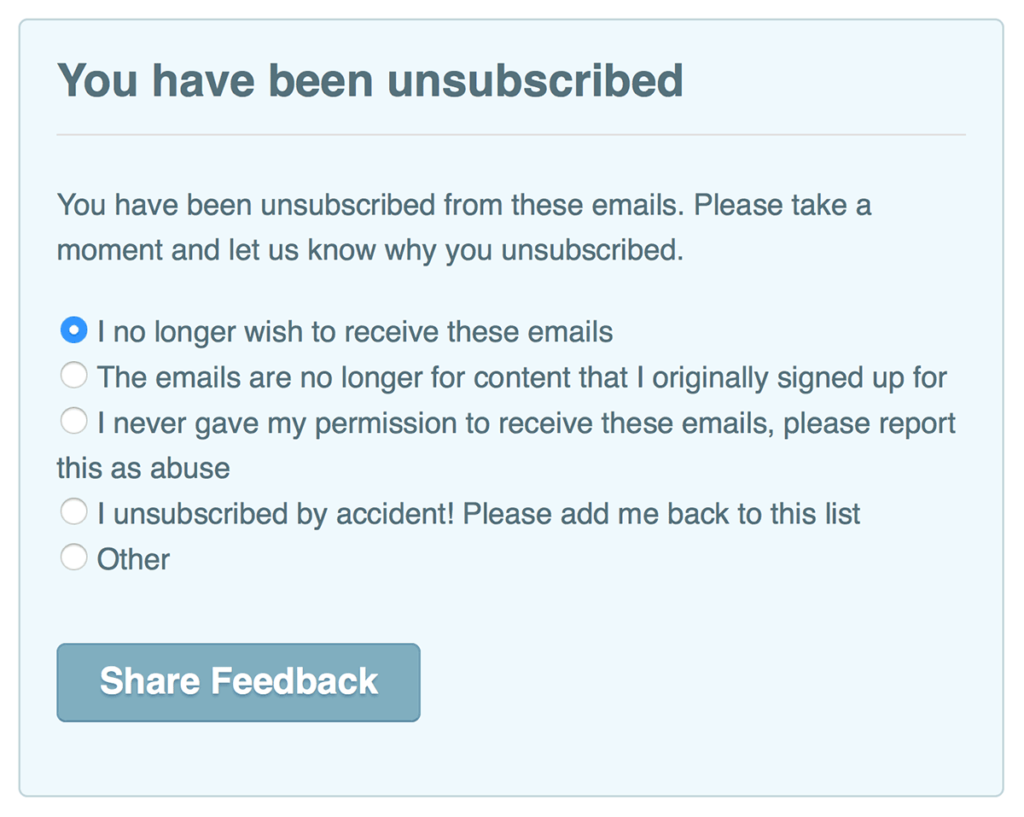
I find this to be beneficial in the long run and should prevent you from making the same mistakes over and over.
4. Be Consistent With Your Sender Name
I mentioned in a recent post that having inaccurate sender information can get your emails sent to spam.
It should also be noted that this is in direct violation of the CAN-SPAM Act and can get you fined as well.
So it’s clear that the sender information should state exactly who you are or who your company is.
But I would like to add another quick point. You should be consistent with the sender name.
In other words, don’t flip-flop between your personal name and your company name. Just choose one and stick with it. Our marketing emails always come from Rikke to build familiarity:
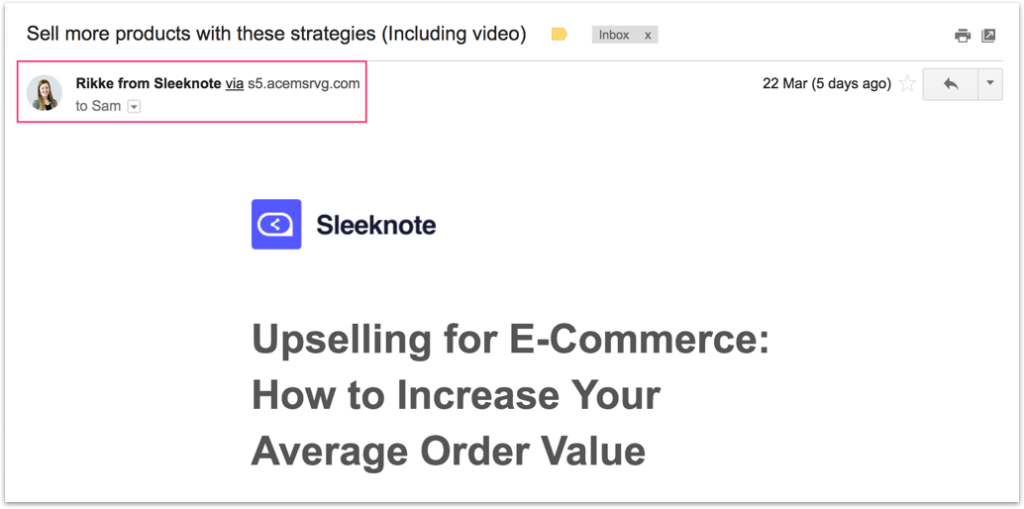
When recipients are able to instantly recognize you, it lowers the likelihood of your emails getting flagged as spam.
5. Don’t Over Do It With Your Emails
Have you ever found yourself interested in a brand—so much so that you eagerly opt-in and anticipate to their emails?
However, you quickly find that the brand is barraging you with a surplus of emails and jamming up your already overflowing inbox.
I’ve seen this happen multiple times, and it’s incredibly annoying.
This is one of the quickest ways to sour a relationship and probably isn’t going to end well.
In some cases, your emails will simply be ignored, which lowers engagement and hurts your IP’s credibility.
Other times, would-be customers will choose to opt-out and will never be heard from again.
Or in a worst-case scenario, they’ll mark your email as spam.
The point here is that over sending is definitely something to avoid at all costs.
Now I realize that “over sending” is inherently subjective and could mean different frequencies to different marketers.
So let’s look at some data from Omnisend to shed some light on how frequently marketers are sending emails across the board.
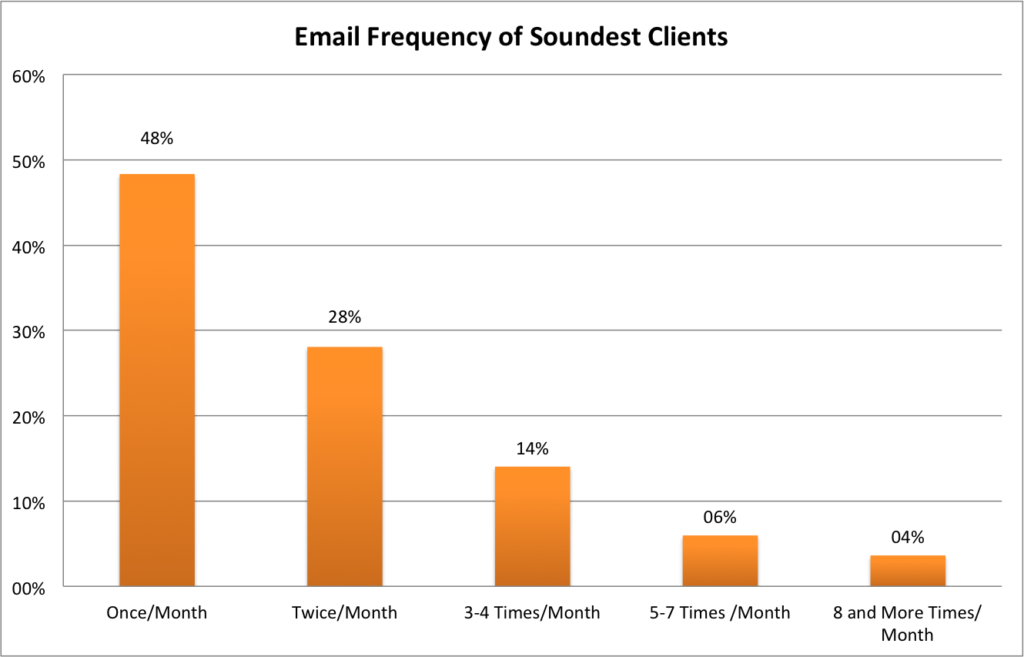
According to their research, the vast majority of marketers (90 percent) send between 1-4 emails per month.
Very few (10 percent) send five or more per month.
While there is no perfect number that applies to every single brand, I think it’s safe to say that any more than eight emails per month is a bad idea.
And in most cases, I would stay away from sending any more than one per week.
This brings me to my next point.
6. Stick to a Consistent Schedule
It’s super important to establish some level of consistency with your emails because being erratic is a good way to get them sent to spam.
As I just mentioned, bombarding subscribers with emails is never a good idea.
But on the other hand, sending them too infrequently isn’t good for brand awareness.
So ideally, you’ll find a nice balance where you’re supplying your subscribers with fresh, interesting content and effectively nurturing your leads without overdoing it or going MIA for long periods.
To find this balance requires a bit of experimentation on your end.
What I suggest is trying out a few different frequencies over the course of a few months to see what’s working best.
For instance, you may try just sending just one email during one month, two emails the following month and four emails the month after that.
Pay close attention to the reaction you get and adjust your frequency accordingly.
Once you find what’s working, stick with it.
7. Use Segmentation
As you’re probably aware, there’s a definite correlation between email engagement and deliverability.
When ISPs see that recipients are opening and engaging with your emails, this helps your IP build trust.
One of the best ways pound-for-pound to send engagement through the roof is by segmenting your email list.
MailChimp even performed a study that compared the results of segmented campaigns against the results of non-segmented campaigns.
Here were the global results:
- Segmented campaigns had a 14.31 percent higher open rate than non-segmented campaigns
- Segmented campaigns received 100.95 percent more clicks than non-segmented campaigns
- Segmented campaigns experienced 4.65 percent fewer bounces than non-segmented campaigns
On top of this, they had 3.9 percent fewer abuse reports and 9.37 percent fewer unsubscribers.
Those are some impressive numbers!
And it’s easy to see why when you consider just how big marketing personalization has become as of late.
In fact, Marketing Insider Group reports, “78 percent of US Internet users said personally relevant content from brands increases their purchase intent.”
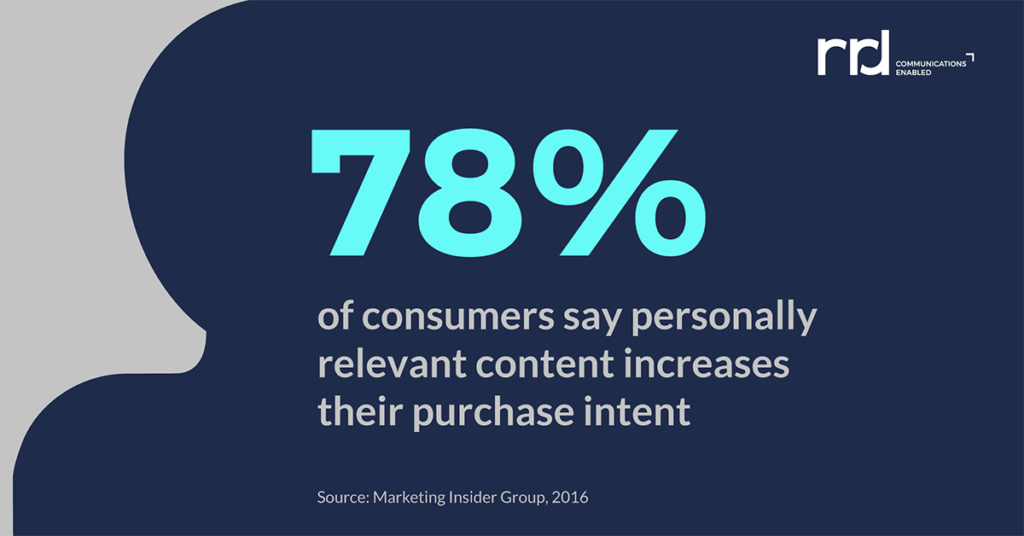
On top of that, Marketo found, “79 percent of consumers say they are only likely to engage with an offer if it has been personalized to reflect previous interactions the consumer has had with the brand.”

The bottom line is that your leads don’t want to receive an email blast for the masses.
What they want are personalized emails that speak to their unique needs and address their specific pain points.
Arguably the best way to personalize your emails is through segmentation based on things like:
- Demographic
- Location
- Past purchases
- Position in the sales funnel
While this approach takes a bit more time than sending out a mass email, it’s far more effective at increasing engagement and ultimately improving deliverability.
8. Create a Suppression List
Let me iterate one last thing—it’s all about sender reputation.
Appeasing ISPs and establishing a positive sender reputation is heavily intertwined with deliverability.
DigitalMarketer makes a great point that not only is it important who you’re sending emails to, it’s just as important who you aren’t sending emails to.
Consequently, they recommend the following:
We also advise clients to not send to their inactive subscribers—the ones who aren’t engaging with their emails—as another way to boost sender reputation and deliverability.
To streamline this process, it’s wise to create a suppression list that contains email addresses of inactive subscribers or anyone who you wish to permanently exclude from sending future emails to.
By doing so, you prevent these recipients from adversely affecting your email deliverability.
The only question is, how long do you wait until you add someone to your suppression list?
While there is no definitive answer, DigitalMarketer offers some straightforward advice.
“The higher your send frequency, the shorter the period of time before you suppress.”
Keep this in mind when choosing who to exclude.
FREE DOWNLOADABLE BONUS
Want More Email Marketing Inspiration?
Let’s face it: writing good marketing emails is TOUGH. To help, we’ve put together an email marketing swipe file, including 41 email marketing examples (organized by category). Plus, a few other goodies not featured below (*cough* killer Facebook Ad examples *cough*).
Download All Resources Now →

Conclusion
I feel like sometimes marketers get so obsessed with the more minute details of email optimization (e.g. finding the perfect number of characters in the subject line or extensively A/B testing CTAs) that they forget about one vital thing—making sure that their emails are actually ending up in subscribers’ inboxes.
This is one of the fundamentals and shouldn’t be overlooked.
When you consider that one out five emails never make it this far, it’s clear that there’s work to be done in this area.
Fortunately, there’s a lot that you can do to improve email deliverability, and the points mentioned here should all help.
And just remember one thing. At the end of the day, your main goal is to improve your sender reputation and ensure that ISPs trust your IP.
As long as the actions you take contribute to achieving that, you should be in good shape.
What do you think is the number one factor that hurts email deliverability?
[ad_2]
Source link